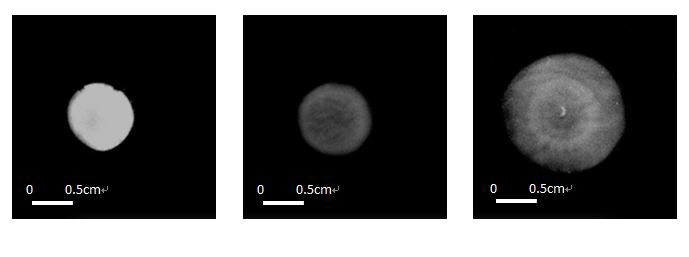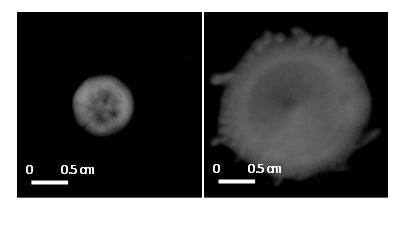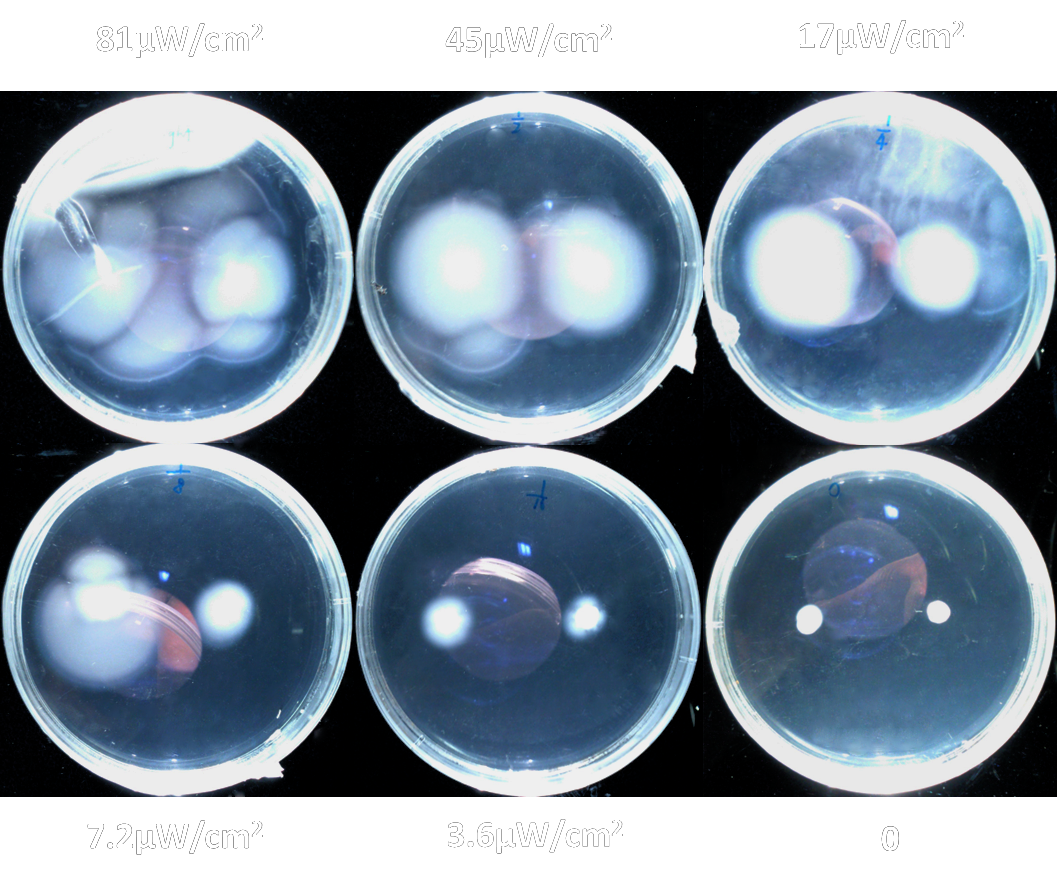Team:Peking/Project/Phototaxis/Demonstration
From 2012.igem.org
| (5 intermediate revisions not shown) | |||
| Line 8: | Line 8: | ||
</script> | </script> | ||
<div class="PKU_context floatR first"> | <div class="PKU_context floatR first"> | ||
| - | <h3 id="title1">Behavioral Analysis of Strains: DH5α, ΔCheZ<br/> | + | <h3 id="title1">Behavioral Analysis of Strains: DH5α, ΔCheZ<br/> and Wild Type MG1655</h3> |
| - | + | <p><i>E.coli</i> performs two types of movements: smooth swimming and tumbling, which is decided by the rotation of the flagellum/flagella. Counter-clockwise rotation leads the bacteria to swim in a straight line, while clock-wise rotation causes the bacteria to tumble in place. As CheZ is essential to determine flagellar rotation, we analyzed the motility of DH5 α strain lacking flagella, ΔCheZ strain K12 AMB1655 from Jian-Dong Huang, and wild type MG1655 on semi-solid medium. | |
| - | <p><i>E.coli</i> performs two types of movements: smooth swimming and tumbling, which is decided by rotation. Counter-clockwise rotation leads the bacteria to swim in a straight line, while clock-wise rotation causes the bacteria to tumble in place. As CheZ is essential to determine | + | <br /><br /> |
| + | During bacterial growth on the semi-solid medium, the energy source where colonies were visible was consumed first, and the possibility of smooth swimming was increased. We expected that wild type MG1655 would diffuse into the surroundings, and ΔCheZ and DH5α would stay in place. The bacterial colonies were grown to mid-exponential phase (OD0.4-0.6) before they were visible on the semi-solid medium. After 20 hours at 30℃, DH5α stayed immobile and formed smooth colonies (Figure 1.a), while the ΔCheZ strain also stayed in place, but formed uneven edges due to tumbling(Figure 1.b), and wild type MG1655 spread to its surroundings and formed larger colonies in the form of a ring (Figure 1.c). The results show that CheZ indeed influences bacteria motility and thus we can regulate the expression level of CheZ in order to control bacterial behavior. | ||
</p> | </p> | ||
<div class="floatC"> | <div class="floatC"> | ||
| Line 23: | Line 24: | ||
<img src="/wiki/images/a/ad/Peking2012_Project_taxis2.JPG" alt="Figure 2" style="width:400px" /> | <img src="/wiki/images/a/ad/Peking2012_Project_taxis2.JPG" alt="Figure 2" style="width:400px" /> | ||
<p class="description">Figure 2. (a) Wild type MG1655; (b) ΔCheZ strain with BBa_J23113 (promoter of medium strength).</p> | <p class="description">Figure 2. (a) Wild type MG1655; (b) ΔCheZ strain with BBa_J23113 (promoter of medium strength).</p> | ||
| + | </div> | ||
| + | </div> | ||
| + | <div class="PKU_context floatR"> | ||
| + | <h3 id="title3">Result</h3> | ||
| + | <p>Experiments show that different light intensity can change diameter of the bacteria colony, indicating light intensity can regulate the bacteria motility. </p> | ||
| + | <div class="floatC"> | ||
| + | <img src="/wiki/images/1/17/Peking2012_phototaxis_result_3.png" alt="Figure 2" style="width:400px" /> | ||
| + | <p class="description">Figure 3. Different light intensity changes the diameter of the bacteria colony</p> | ||
</div> | </div> | ||
</div> | </div> | ||
Latest revision as of 17:10, 26 October 2012
Behavioral Analysis of Strains: DH5α, ΔCheZ
and Wild Type MG1655
E.coli performs two types of movements: smooth swimming and tumbling, which is decided by the rotation of the flagellum/flagella. Counter-clockwise rotation leads the bacteria to swim in a straight line, while clock-wise rotation causes the bacteria to tumble in place. As CheZ is essential to determine flagellar rotation, we analyzed the motility of DH5 α strain lacking flagella, ΔCheZ strain K12 AMB1655 from Jian-Dong Huang, and wild type MG1655 on semi-solid medium.
During bacterial growth on the semi-solid medium, the energy source where colonies were visible was consumed first, and the possibility of smooth swimming was increased. We expected that wild type MG1655 would diffuse into the surroundings, and ΔCheZ and DH5α would stay in place. The bacterial colonies were grown to mid-exponential phase (OD0.4-0.6) before they were visible on the semi-solid medium. After 20 hours at 30℃, DH5α stayed immobile and formed smooth colonies (Figure 1.a), while the ΔCheZ strain also stayed in place, but formed uneven edges due to tumbling(Figure 1.b), and wild type MG1655 spread to its surroundings and formed larger colonies in the form of a ring (Figure 1.c). The results show that CheZ indeed influences bacteria motility and thus we can regulate the expression level of CheZ in order to control bacterial behavior.

Figure 1. (a)(b)(c) DH5 α, ΔcheZ and wild type MG1655 on semi-solid medium, respectively. The medium contains 5g tryptone, 2.5g yeast extract, 5g NaCl per liter, and 0.25% agar, buffered by HEPES (pH 8.0, final concentration 20mM), and 0.5% (w/v) glycerol was added as the carbon source. 20ml of the above medium was poured into Petri-dish (9cm internal diameter), and harden at 30℃ for 1h. 2μL cell culture(OD0.4-0.6) was spotted at the center of the plate and dried for 15min. Incubated at 30℃ for 20h.
Recovery of Motility
As CheZ influences bacterial behavior, we suspected that bacteria would have different diffusion radius associated with expression level of CheZ. We constructed CheZ under the control of promoters with different strength: BBa_J23112, BBa_J23113, and BBa_J23114, following which these constructs were transformed into ΔCheZ strain, respectively. It shows that ΔCheZ strain diffuses and forms larger colonies in the form of a ring similar with wild type MG1655 (Figure 2b). The results indicate that CheZ can be regulated and the expression level of CheZ and bacterial motility have positive correlation.

Figure 2. (a) Wild type MG1655; (b) ΔCheZ strain with BBa_J23113 (promoter of medium strength).
Result
Experiments show that different light intensity can change diameter of the bacteria colony, indicating light intensity can regulate the bacteria motility.

Figure 3. Different light intensity changes the diameter of the bacteria colony
Reference
- 1. Chenli Liu, et al.(2011) Sequential Establishment of Stripe Patterns in an Expanding Cell Population. Science, 334:238:241
- 2. J.Adler and Bonnie Templeton.(2011)The Effect of Environmental Conditions on the Motility of Escherichia coli. J. gen. Microbiol, 46:175:184
 "
"














